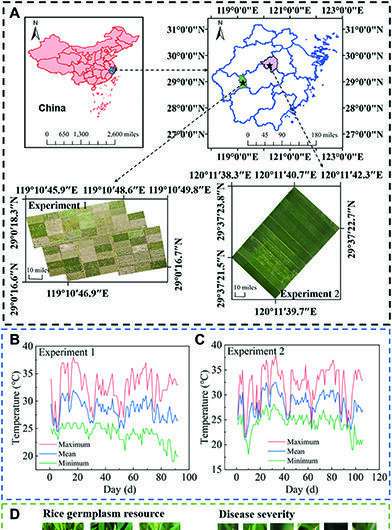This article has been reviewed according to Science X's editorial process and policies. Editors have highlighted the following attributes while ensuring the content's credibility:
fact-checked
trusted source
proofread
Eyes in the sky: Using drones to assess the severity of crop diseases

Rice is one of the most important crops in the world and constitutes the primary food source for over half of Earth's population. Protecting rice plantations from disease is therefore an essential endeavor in modern agriculture. Of the many pathogens that can infect rice plants, the bacterium Xanthomonas oryzae, which is responsible for bacterial blight (BB), is among the worst. Hundreds of millions of dollars' worth of crops are lost each year due to BB, and millions of dollars are spent in preventive measures and research.
One of the most fruitful strategies to control BB and other crop diseases is to grow genetically resistant cultivars. However, as pathogens can evolve rapidly, researchers have to constantly explore new genes that grant resistance and apply them when breeding. Hence, they have to regularly sample multiple rice plants at different times of the year and measure their response to bacterial infection, which represents manually intensive and time-consuming labor.
But what if we leveraged modern technologies to greatly simplify this process? In a recent study published in Plant Phenomics, a research team led by Dr. Xuping Feng from Zhejiang University, China, developed an innovative strategy that combines drones and machine learning to both gauge BB outbreaks in the field and screen for potentially resistant genes.
The researchers set up two experimental sites in Zhejiang Province, China, where they grew over 60 types of rice cultivars with different resistance to BB. Using unmanned aerial vehicles (UAVs, better known as 'drones') equipped with regular and multispectral cameras, they imaged the crop sites at different stages of rice plant development. Afterwards, they combined these UAV images with accumulated temperature (AT) data and used them to train a deep learning model to evaluate the severity of BB.
Worth noting, fusing AT data with UAV imaging data taken at different stages of rice plant growth was a strategy unique to this study. The team found that this information was enough for the trained model to make accurate predictions about BB severity. Moreover, the researchers also tested whether a model trained with data gathered at one site could be supplied with a small amount of training data gathered at a different site to improve its predictions on the latter.
Fortunately, their results were very promising, as Dr. Feng observes: "Considering the cost of field sampling, we found that a transfer of only 20% of new data was a useful and cost-effective model updating strategy to achieve reliable predictions of BB severity across different sites."
The researchers then sought to use this new method for effectively measuring BB severity using UAVs to perform quantitative trait loci (QTL) mapping.
"QTL mark the location in the genome where a gene controls specific quantitative traits, such as susceptibility to a disease. Mapping QTL to crop responses under pathogen stress can help breeders identify the functions or traits of crops that a given set of QTLs controls," explains Dr. Feng. Put simply, QTL mapping involves analyzing the genome of multiple samples of an organism and trying to pinpoint which genes could be responsible for a target trait, including disease resistance.
In this study, the team determined BB disease severity in the crops indirectly using UAV images and combined this information with the results of genetic analysis of multiple rice samples taken at different growth stages and from different cultivars. Through this approach, the researchers managed to detect both previously identified QTLs related to BB resistance, as well as three new ones!
As shown by the results, the overall strategy outlined in the study could become a real time saver in agricultural disease research. "Compared with manual measurements of disease severity, UAV remote sensing techniques enable us to gather large-scale phenotypic information rapidly, which provides technical support for accelerating breeding research," concludes Dr. Feng. Most importantly, while the approach was developed and tested specifically for rice and BB, it could be adapted to other crops and diseases as well.
More information: Xiulin Bai et al, Dynamic UAV Phenotyping for Rice Disease Resistance Analysis Based on Multisource Data, Plant Phenomics (2022). DOI: 10.34133/plantphenomics.0019
Provided by NanJing Agricultural University


















